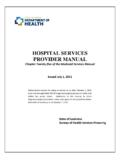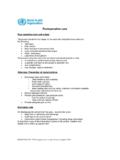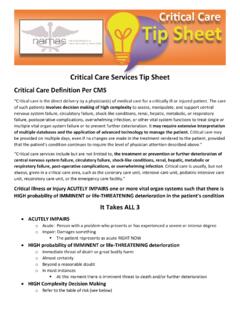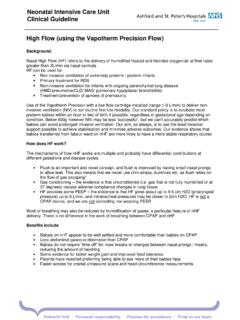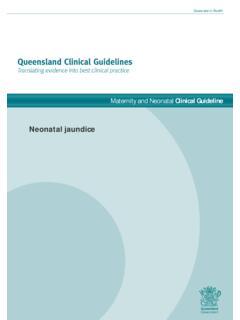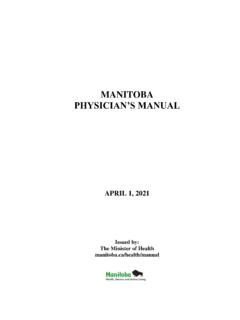Transcription of Neonatal thermoregulation - Infant journal
1 VOLUME 3 ISSUE 3 2007101infantTHERMOREGULATION 2007 SNL All rights reserved Hypothermia at birthImmediately after delivery if no action istaken, the core and skin temperatures of aterm neonate can decrease at a rate ofapproximately C and C per minuterespectively9. The World HealthOrganisation defines mild hypothermia asa core body temperature of 36 C,moderate hypothermia as C-32 C andsevere hypothermia as less than 32 C10. Therapid decline in temperature is mainly dueto physical characteristics of the newbornand environmental factors of the deliveryarea. Typically a wet newborn with a highsurface area to volume ratio moves from awarm aqueous uterine environment into acooler, dry delivery room9,11. The newbornimmediately loses heat by evaporation,convection, conduction and radiation,dependent on the ambient air pressure,temperature and humidity and thetemperature of surrounding surfaces12,13.
2 As the temperature falls between 36 C to35 C, newborn infants peripherallyvasoconstrict and initiate non-shiveringthermogenesis (NST) of brown adiposetissue14,15. Non-shivering and shiveringthermogenesis from immature skeletalmusculature is insignificant16. Brown fatconstitutes approximately percent ofthe body mass of newborns greater than 2kilograms in weight and is prominent innuchal subcutaneous tissue, around thekidneys, the mediastinium and intra-scapular regions17. Brown fat contains highlevels of triglycerides, is rich in capillariesand is innervated by sympathetic nervefibres. NST is triggered by a surge incatecholamines, released from thesympathetic nervous system during timesof cold stress. Noradrenaline combineswith beta 3 adrenoreceptors on brownadipocytes and activates adenylate cyclasewhich increases cytosolic cyclic adenosinemonophosphate, phosphorylates proteinkinase, and activates hormone-sensitivelipase.
3 Uncoupling of oxidativephosphorylation by the proteinthermogenin results in marked heatproduction18, and a significant increase inmetabolic rate19,20. With continued coldstress the stores of brown fat becomedepleted resulting in hypoxia andhypoglycaemia21. Brown adipose tissue can be identifiedafter 26 weeks gestation22. Post deliverybrown adipose tissue does not continue todevelop, as it would have done in the intra-uterine environment, so preterm neonatesremain at a disadvantage. The preterminfant has the additional disadvantages ofdecreased fat for insulation, decreasedglycogen stores, immature skin whichincreases water loss, poor vascular control,a lower maximal metabolism and anarrower range of thermal control11,20, loss on NICUR educing heat losses in the first few days oflife, particularly in preterm neonates hasbeen known to be associated withimproved survival since the early transepidermal water loss andconsequential evaporative heat loss due tostructurally and functionally immatureskin is a major problem for extremelypremature neonates24.
4 Transepidermalwater loss decreases with increasingpostnatal age (FIGURE 1), however at fourto five weeks postnatal age, 25-27 weekgestational age infants still have losses twicethose of their term counter parts25. ANeonatal thermoregulationSince the first use of mercury in glass thermometers in 17981, the importance ofthermoregulation in clinical care has been appreciated. In no discipline is this more acute than inthe management of premature neonates. Hypothermia at birth is a worldwide problem2-4. TheEPICure study highlighted that for neonates less than 26 weeks gestation a temperature of<35 C on admission to a Neonatal unit was independently associated with death5. Heat loss is aparticular problem at resuscitation6. Hypothermia can also occur during transfer of infants toneonatal units, during routine care7and in operating theatres8. Similarly, hyperthermia can havesevere adverse consequences and should be avoided6.
5 Current routine Neonatal practice isfounded upon preventing significant temperature WaldronMBCHBC linical FellowPaediatric intensive care UnitRoyal Manchester Children s Hospital,ManchesterRalph MacKinnonBSc (Hons), MBCHB, FRCAH onorary Lecturer, University of Manchesterand Consultant Paediatric Anaesthetist,Regional Neonatal Surgical UnitSt Mary s Hospital, thermoregulation ; temperaturecontrol; hypothermia; hyperthermiaKey pointsWaldron, S., Mackinnon, R. (2007) Neonatal thermoregulationInfant3(3) Newborn infants are acutely vulnerableto the harmful effects of thermal Preventing damaging heat loss frompremature neonates at delivery remainsa significant More research is required to develop anevidence base for heat loss preventionat Neonatal Hyperthermia has been associated withpoor neurological outcome, and hasstimulated research into 3 ISSUE 3 2007infantachievable10.
6 The immediate drying of theinfant under radiant heat, discarding thewet towel and replacing it with a warmtowel, in a warm draught-free area isrecommended33-35. However very lowbirthweight (<1500 g) preterm babies arelikely to become hypothermic despite allthese measures5. As a consequence,recommendations to place newbornsinside plastic wrapping or bags with theirheads protruding, have been recent Heat Loss Prevention (HeLP)randomised controlled trial found thatpolyethylene occlusive skin wrappingprevented heat loss at the delivery ofinfants less than 28 weeks gestational should continue unhinderedby the heat loss preventative measures. A number of other methods to maintaintemperature have been described, theseinclude swaddling close to mother with aspecial blanket39. These measures have notbeen evaluated in any randomisedcontrolled trials. A recent Cochrane reviewwas not able to provide any firmrecommendations due to small samplesizes and lack of follow-up data40.
7 It isimportant to closely measure temperatureas hyperthermia associated withpolyethylene bags and a third degree burnwith a thermal heat pack have on NICUThe mainstay of care is to maintain thenewborn in a neutral thermal environmentwhich ensures minimal metabolic activityand oxygen consumption are required toconserve body temperature43. Incubatorsare now specifically designed to minimiselosses by radiation, convection, conductionand evaporation whilst allowingclear visibility and access to the patient(FIGURE 2). Ambient temperature andhumidity are easily controlled. A skintemperature probe is placed away fromregions where brown fat metabolismoccurs and should be reflective if under aradiant warmer. All newborns should havea hat to prevent excessive heat loss fromthe head. Plastic wrapping and increasedvigilance regarding maintainingtemperature control should be instigatedfor any transfers.
8 Re-warming after a period ofhypothermia should be a well controlled,closely observed treatment, monitoring forhypoxaemia and metabolic acidosis,cardiovascular instability, hydration status,hypoglycaemia and signs of cold stressDuring development of hyperthermia, aneonate may become cold to the touch,restless, irritable or lethargic, hypotonic, apoor feeder with gastric distension orincreased aspirates, and bradycardic. As thecondition worsens the neonate can becometachypnoeic or apnoeic, hypoglycaemic28,hypoxic and metabolically acidotic29,develop coagulation defects, acute renalfailure and necrotizing enterocolitis30andultimately die28. Risk factors All neonates are at risk of hypothermiawithin the first twelve hours of life,particularly the extremely premature and growth retarded infants. Other riskfactors include abnormal skin integrityincluding gastroschisis, exomphalos andneural tube defects and neonates withneurological impairment global or to the hypothalamus in infants or those alreadysignificantly metabolically stressed are also at measures temperature control atresuscitation Traditional techniques for decreasing heatloss include the provision of a warmdelivery room.
9 A temperature of 25 C issuggested though this is not alwaysprospective study of modern standardisedhygiene care regimes of extremely lowbirthweight neonates highlighted sharpperipheral and core temperature falls,despite procedures to minimise loss during neonataloperationsThe transfer of neonates out of incubatorsfor investigations or operative proceduresunquestionably increases the risk of heatloss. A recent study highlighted that tenminutes after induction of anaesthesia in aseries of neonates, the core temperaturesbegan to fall. If the operating room wasbelow 23 C the losses continued to the endof the procedures8. The reason for thedecrease in body temperature duringanesthesia is not that anaesthesia itself isassociated with a loss of thermoregulation ,but rather that a broadening of thetolerated core temperatures occurs26,27. It ispostulated that because of their highamounts of brown adipose tissue and thustheir high potential for nonshiveringthermogenesis, neonates should be able toproduce more heat to compensate for heatloss.
10 However unlike other small mammalswho can and do perform nonshiveringthermogenesis under anaesthesia, neonatesdo not26,27. Neonates like adults are unableto respond to mild intraoperativehypothermia, despite maintaining otherthermoregulatory responses26,27. 60504030201002628 30 32 34 36382826242220181614121086420 Gestational age (weeks)Transepidemal water loss (g/m2/h)Postnatal age (days)FIGURE 1 The relationship between transepidermal water loss and the age (gestational andpostnatal) of rewarming has been advocated44butmay be associated with vasodilatation implications ofhyperthermiaNeonatal hyperthermia is defined as abody temperature above C10. Therehave been reports of Neonatal seizures innewborns of febrile mothers45,46. It has beenpostulated from animal studies thathyperthermia during or after hypoxic-ischaemic events may cause Neonatal braininjury47,48.


